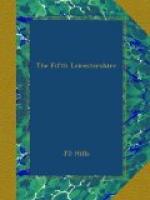But such a success cannot be purchased without loss, and our losses had been heavy. The Staffordshires had not lit their straw because of the wind, so that the enemy’s retaliation, which should have been spread along the whole front from “A1” to “Hill 60” was concentrated entirely on our three trenches “40,” “50” and “A1.” “C” Company (Lt. R.D. Farmer) in “50” suffered most. Choked and blinded by the smoke from the straw, which blew back and filled the trench, their parapet blown away by salvo after salvo of small shells, their supports battered with 8” and heavy mortars, with no cover against the unceasing rain of shells from front and left, they had to bear it all in silence, unable to hit back. Serjts. J.G. Burnham and J. Birkin were killed, and with them 10 others of the battalion, while 30 more were wounded. Once more the “Doc.” and his stretcher-bearers were everywhere, and many who might otherwise have bled to death, owed their lives to this marvellous man, who wandered round and dressed their wounds wherever the shelling was hottest. At the first opening of the battle our telephone lines to the Artillery were broken, and for some time we could get no support, but the Derby Howitzers and one of the Lincolnshire batteries fired a number of rounds for us, and later, thanks to the efforts of Lieut. C. Morgan, R.F.A., the F.O.O., we were able to call on Major Meynell’s Staffordshire battery as well. By 7.15 a.m. all was once more quiet, and we spent the rest of the day evacuating our casualties, and trying to clear away some of the litter of straw from our trenches.
The following day passed quietly, and in the evening, relieved by the Lincolnshires, we marched out of trenches. Ten minutes later the enemy blew up trench “47” and opened heavy rifle fire on all sides of the salient. The Battalion was marching by companies, and “A” and “D” had just reached Manor Farm when the noise began, and bullets fell all round them. Capt. Jefferies, who was leading, was hit almost at once and fell mortally wounded, never again recovering consciousness, and several others became casualties before the party could reach cover on the far side of the Farm. “B” and “C” were still in Armagh Wood, so Colonel Jones at once decided to man the new breastwork between it and Square




